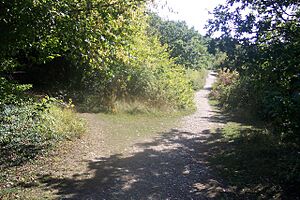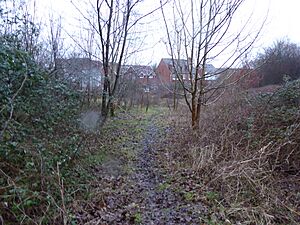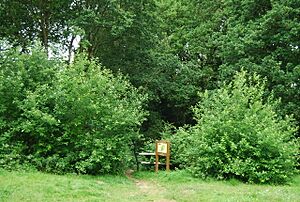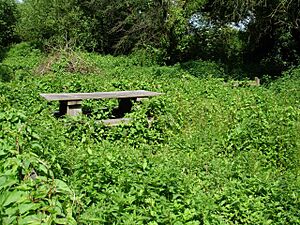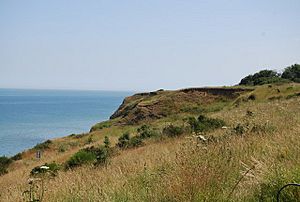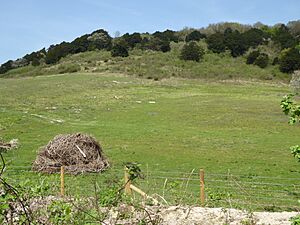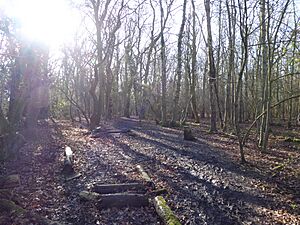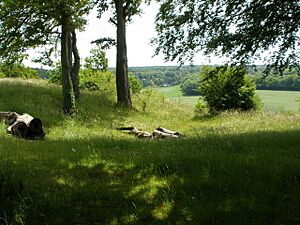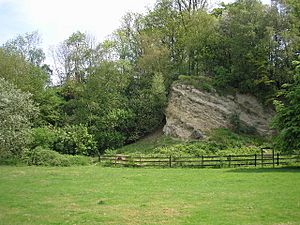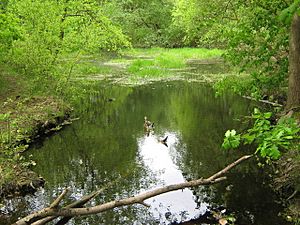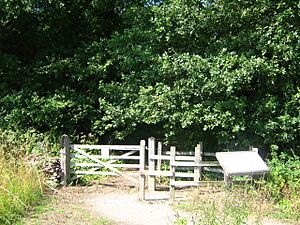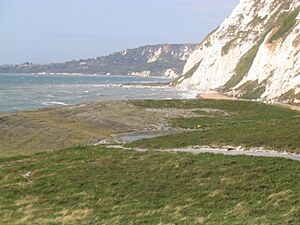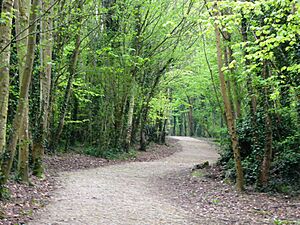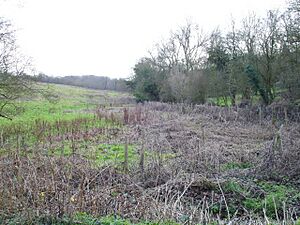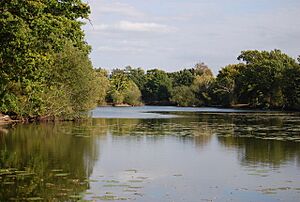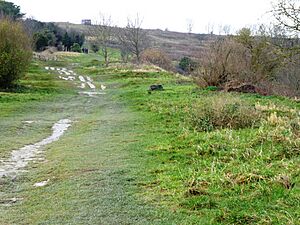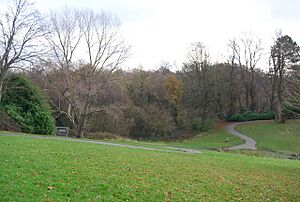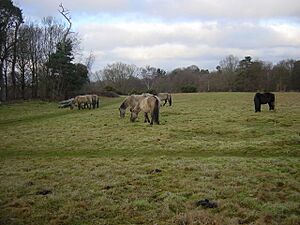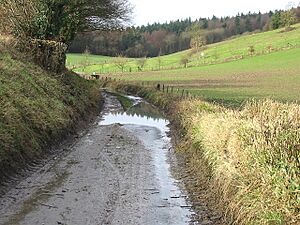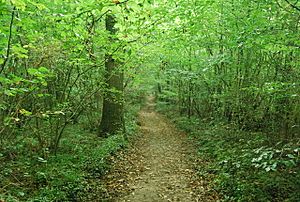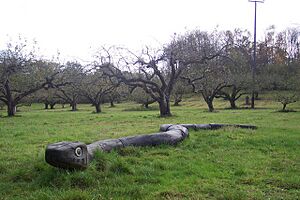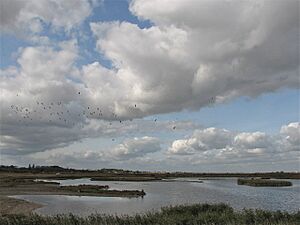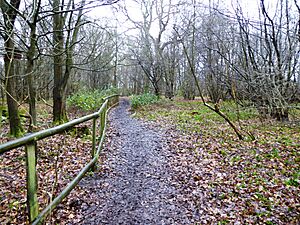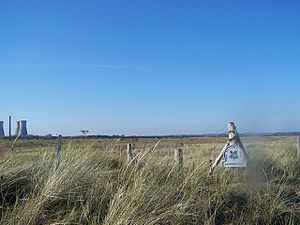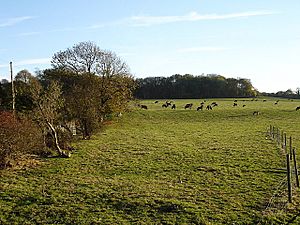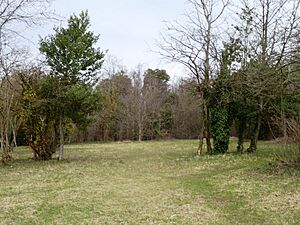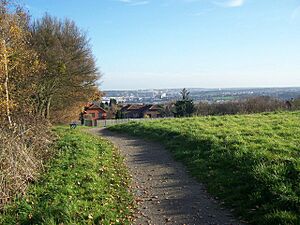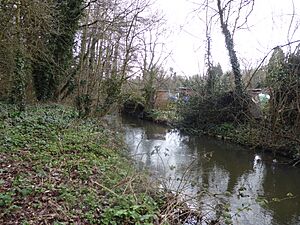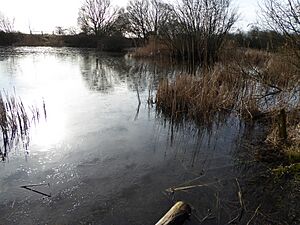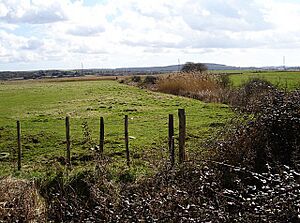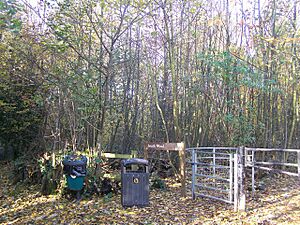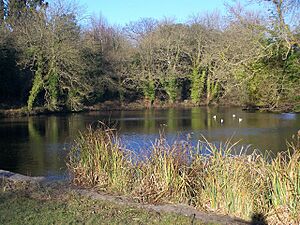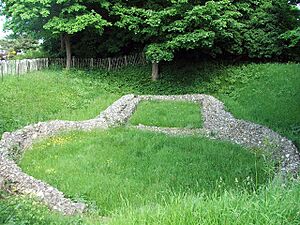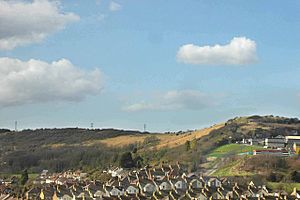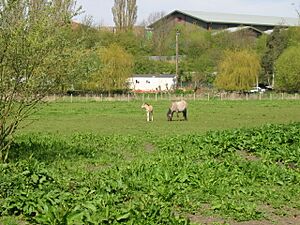List of local nature reserves in Kent facts for kids
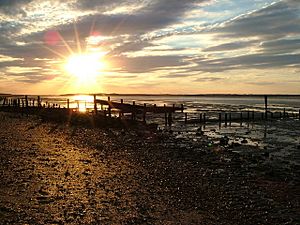
Kent is a county located in the southeastern part of England. It shares borders with Greater London and the Thames Estuary to the north, Sussex and Surrey to the west, and the English Channel and North Sea to the south and east. The main town in Kent is Maidstone.
Local nature reserves are special places protected by local authorities. They are chosen because they have unique plants, animals, or interesting geology. These areas are important for nature and are managed to keep them safe and healthy for everyone to enjoy. As of May 2018, Kent has 42 of these amazing local nature reserves!
Contents
- Understanding Special Nature Areas
- Exploring Kent's Nature Reserves
- Ambley Wood
- Ashford Community Woodland
- Ashford Green Corridors
- Barnett's Wood
- Baty's Marsh
- Berengrave Chalk Pit
- Bishopstone Cliffs
- Boxley Warren
- Bus Company Island
- Crane Valley
- Curtis Wood
- Darland Banks
- Ditton Quarry
- Dryhill
- Farningham Wood
- Foal Hurst Wood
- Folkestone Warren
- Foxburrow Wood
- Foxes Cross Bottom
- Haysden Country Park
- High Meadow
- Hilbert Woods
- Hothfield Common
- Jumping Downs
- Larkey Valley Wood
- Levan Strice
- No Man's Orchard
- Oare Marshes
- Poulton Wood
- Prince's Beachlands
- Queendown Warren
- Rectory Meadow
- Rede Common
- River Len
- Romney Warren
- Seasalter Levels
- South Bank of the Swale
- South Wood
- Tyler Hill Meadow
- Vinters Valley Park
- Western Heights
- Whinless Down
- Whitehall Meadows
- See also
- Sources
Understanding Special Nature Areas
When we talk about nature reserves, you might see some special terms. Here's what they mean:
- KWT = Kent Wildlife Trust: This is a charity that helps protect wildlife and wild places in Kent.
- GCR = Geological Conservation Review: These sites are important because they show us a lot about Earth's history through rocks and fossils.
- NCR = Nature Conservation Review site: These are top sites in Britain for nature conservation.
- NNR = National nature reserve: These are the most important places for wildlife and geology in the UK.
- Plant = Plantlife: This is a charity focused on protecting wild plants.
- Ramsar = Ramsar site: These are wetlands that are super important around the world, especially for water birds.
- SAC = Special Area of Conservation: These sites protect some of Europe's most endangered habitats and species.
- SM = Scheduled monument: This means the site also contains an important historical or archaeological feature.
- SPA = Special Protection Area: These areas are protected for rare and vulnerable birds, as well as for regularly occurring migratory birds.
- SSSI = Site of Special Scientific Interest: These are areas that are important for their wildlife or geology in the UK.
Exploring Kent's Nature Reserves
Let's take a closer look at some of the amazing local nature reserves you can find in Kent!
Ambley Wood
Located in Gillingham, Ambley Wood covers about 14 hectares. This ancient woodland is home to many typical forest plants and animals. It's a great spot to see what old forests are like.
Ashford Community Woodland
Near Ashford, this woodland is about 13.8 hectares. Most of its broadleaf trees were planted in 1985. You can also find open grasslands and scrub here. Look out for birds like the skylark and yellowhammer, and butterflies such as marbled whites.
Ashford Green Corridors
This large site, about 47.4 hectares, is also in Ashford. It features a lake, ponds, meadows, and parkland. Kingfishers are often seen by Singleton Lake, adding a splash of color!
Barnett's Wood
Found in Tunbridge Wells, Barnett's Wood is 12.4 hectares. It has very old, natural woodland and untouched grasslands. Cows graze in the meadows, helping wildflowers like bird's-foot trefoil and common spotted orchid to grow.
Baty's Marsh
This 10.4-hectare marsh is in Rochester. It's one of the last remaining salt marshes in the Medway area. It's a fantastic place for wildlife, especially wading birds.
Berengrave Chalk Pit
Located in Rainham, this 9.5-hectare site was once a chalk pit. Now, it has a small lake, scrub, woodland, and reedbeds. These reedbeds sometimes flood, creating areas of willow trees.
Bishopstone Cliffs
These cliffs near Herne Bay span 67.4 hectares. It's a grassland area on top of the cliffs, home to some rare insects. Sand martins build their nests in holes in the cliffs, and you might also see skylarks and meadow pipits. This site is also a Ramsar wetland and a SPA.
Boxley Warren
At 83 hectares, Boxley Warren near Maidstone is a large yew woodland with many different plants and animals. It's special because it includes the White Horse Stone, an ancient Neolithic standing stone. This site is also a SAC and a SM.
Bus Company Island
This small, 1.1-hectare site in Canterbury was once a watermill and then a bus park. Now, it's a meadow and orchard, important for monitoring reptiles.
Crane Valley
In Cranbrook, Crane Valley is a small 0.8-hectare site. Much of it is wet woodland with lots of plants, including the rare large bitter-cress. Drier parts have natural woodland with oak and hornbeam trees.
Curtis Wood
Curtis Wood, 5.3 hectares near Herne Bay, is known for its many ground plants. You can find beautiful early purple and greater butterfly orchids here. There's also a semi-improved meadow.
Darland Banks
This 29.1-hectare site in Gillingham has grasslands, scrub, and woodland. It's famous for having the largest number of man orchids in Britain! Birds like willow warblers and yellowhammers also live here. It is managed by the KWT.
Ditton Quarry
Once a quarry, this 5.6-hectare site in Aylesford is now a haven for wildlife. It has grasslands and scrub, with butterflies, foxes, rabbits, frogs, and newts. The meadows are full of wildflowers.
Dryhill
Dryhill, 9.4 hectares near Sevenoaks, was also a quarry. It's special because it shows rocks from about 120 million years ago! It's famous for its many brachiopod and bivalve fossils, which help scientists study ancient environments. This site is a GCR site and a SSSI.
Farningham Wood
This large wood, 69.3 hectares in Dartford, has different soil types, leading to a wide variety of plants and insects. Some insects are typical of very old woodlands. Ponds in the middle are home to several types of amphibians. It is a SSSI.
Foal Hurst Wood
Foal Hurst Wood, 12.9 hectares near Paddock Wood, is mostly coppiced woodland (where trees are cut back to encourage new growth). There's also grassland at the northern end. You might see green and great spotted woodpeckers, and various orchids.
Folkestone Warren
These chalk cliffs near Folkestone cover 83.6 hectares. They are home to several rare plants and provide nesting spots for cliff birds in winter. The site is also important for studying the Cretaceous period in Earth's history. It is a SSSI.
Foxburrow Wood
Foxburrow Wood, 6.1 hectares in Rainham, is a small piece of a much larger old forest. It has plants like herb paris and bluebells, which tell us it's an ancient woodland.
Foxes Cross Bottom
This 4-hectare site near Whitstable has a mix of grasslands, scrub, woodland, ponds, and hedges. Ponies and highland cattle graze the meadows, helping to keep the plant life varied.
Haysden Country Park
Haysden Country Park, 64 hectares near Tonbridge, is crossed by the River Medway. It has two lakes, marshes, woods, and grasslands. Look for plants like Dyer's Greenweed here.
High Meadow
This 21.3-hectare hilltop meadow near Dover offers amazing views. Konik horses graze here, which helps protect the many different plants and animals. You can find fragrant, common spotted, and pyramidal orchids.
Hilbert Woods
Hilbert Woods, 14.3 hectares in Tunbridge Wells, is a gently sloping wood. On the dry upper slopes, you'll find oak, hazel, and beech trees. Lower down, near a stream, there's alder. This wood is rich in insects, including some rare kinds.
Hothfield Common
This 56.6-hectare site near Ashford has rare heathland and the best valley bog in Kent. Over a thousand insect species have been recorded here, including some that are nationally rare. It is managed by the KWT and is a SSSI.
Jumping Downs
Jumping Downs, 5.7 hectares in Canterbury, is a chalk downland. You might spot adders, viviparous lizards, and slow worms. Small mammals like wood mice and pygmy shrews also live here.
Larkey Valley Wood
This 44.4-hectare wood in Canterbury has many different ground plants, including some uncommon ones. It's also a great place for birdwatching, with tree pipits, nuthatches, and hawfinches. The rare lady orchid can be found here. It is a SSSI.
Levan Strice
Levan Strice, 2.8 hectares in Gillingham, is a small piece of ancient woodland with its special plants, surrounded by houses.
No Man's Orchard
This 4.1-hectare site in Canterbury is called "No Man's Orchard" because it sits on the border between two parishes. It's one of the few traditional orchards left in the Stour Valley.
Oare Marshes
Oare Marshes, 71.4 hectares near Faversham, has salt marshes, freshwater ditches, and reed beds. It's super important internationally for migratory, overwintering, and breeding wetland birds like avocets and marsh harriers. It is managed by the KWT and is a NNR, Ramsar, SPA, and SSSI.
Poulton Wood
This 10.2-hectare woodland near Ashford has coppiced oak, hornbeam, and ash trees. In spring, you'll see bluebells. It's managed as a conservation project, teaching people about woodland care.
Prince's Beachlands
Prince's Beachlands, 6 hectares near Ramsgate, has many different habitats and is important globally for its seabirds. It's also known for its butterflies, fungi, and reptiles. It is managed by the KWT and is a NCR, Ramsar, SAC, SPA, and SSSI.
Queendown Warren
Queendown Warren, 22.2 hectares near Rainham, has dry grassland and woodland on a south-facing slope. It's home to two rare plants, early spider orchid and meadow clary, and many different insects. It is managed by the KWT and Plantlife, and is a NCR, SAC, and SSSI.
Rectory Meadow
This 2.2-hectare site in Longfield has chalk grassland and woodland. Over 190 types of plants have been found here, including man orchids and cornflowers.
Rede Common
Rede Common, 11.2 hectares in Strood, is also known as Sandy Banks because of its sandstone ground. It used to be farmland but is now open acid grasslands surrounded by scrub and trees.
River Len
This small, 1.7-hectare site in Maidstone is in an urban area next to the River Len. It's home to some uncommon species like water voles and soldier beetles.
Romney Warren
Romney Warren, 10.9 hectares near New Romney, is made of ancient sand dunes left behind as the sea moved back over thousands of years. It has plants like sea spurrey and ponds from old gravel extraction. It is managed by the KWT and is a Ramsar and SSSI.
Seasalter Levels
This 71.4-hectare freshwater grazing marsh near Whitstable is very important for wildfowl and wading birds. In winter, you can see many wigeons, redshanks, and lapwings. It is a Ramsar, SPA, and SSSI.
South Bank of the Swale
This large coastal site, 410.5 hectares near Whitstable, has wetlands and grasslands. Its mudflats attract many wading birds and wildfowl in winter. You can find plants like yellow horned-poppies and sea-lavender. It is managed by the KWT and is a Ramsar, SPA, and SSSI.
South Wood
South Wood, 6.6 hectares in Gillingham, was once used for timber but is now a nature reserve. It's home to dormice, which are rare in Britain and Europe.
Tyler Hill Meadow
This small, 0.8-hectare site in Canterbury has untouched grassland, woodland, and scrub. You might see slow-worms and lizards, and at least eleven types of butterflies have been recorded here.
Vinters Valley Park
Vinters Valley Park, 30.2 hectares in Maidstone, has many different habitats including grassland, woods, marshes, a lake, and a stream. It's a great place to see ducks, geese, and kingfishers.
Western Heights
This 51.7-hectare green area in Dover surrounds the Dover Western Heights, old fortifications from the Napoleonic Wars. It has chalk meadows with many wildflowers, butterflies, and birds.
Whinless Down
From Whinless Down, 19.3 hectares in Dover, you can see Dover Castle. This area has rare plants like cypress spurge and horseshoe vetch, as well as uncommon butterflies and moths.
Whitehall Meadows
Whitehall Meadows, 11.6 hectares in Canterbury, is a wet meadow. It's home to many damp-loving creatures, including snails, butterflies, damselflies, dragonflies, and reptiles.
See also
- List of Sites of Special Scientific Interest in Kent
- Kent Wildlife Trust
Sources


